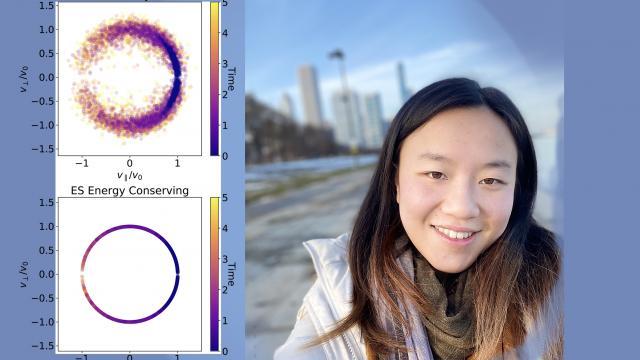
Credit: Collage by Elle Starkman/PPPL Office of Communications.
Unlocking the zig-zagging dance of hot, charged plasma particles that fuel fusion reactions can help to harness on Earth the fusion energy that powers the sun and stars. At the U.S. Department of Energy’s (DOE) Princeton Plasma Physics Laboratory (PPPL), an experimentalist and two theorists have developed a new algorithm, or set of computer rules, for tracking volatile particles that could advance the arrival of safe, clean and virtually limitless source of energy.
Close interaction
“This is a success story about close interaction between theorists and experimentalists that shows what can be done,” said Hong Qin, a principal theoretical physicist at PPPL. He and Yichen Fu, a theoretical graduate student whom he advises, collaborated on the algorithm with Laura Xin Zhang, an experimental graduate student and lead author of a paper that reports the research in the journal Physical Review E. Qin and Fu coauthored the paper.
Fusion powers the sun and stars by combining light elements in the form of plasma — the state of matter composed of free electrons and atomic nuclei, or ions, that makes up 99 percent of the visible universe — to release massive amounts of energy. Scientists around the world are seeking to produce controlled fusion on Earth as an ideal source for generating electricity.
The new PPPL algorithm helps track fast charged particles in the plasma. The particles could, for example, stem from the injection of high-energy neutral beams that are broken down, or “ionized” in the plasma and collide with the main plasma particles. “We care about this because we want to understand how these fast particles influence the plasma,” Zhang said.
Neutral beams play many roles when broken down into fast plasma particles. “We use them to do all sorts of things,” Zhang said. “They can heat and drive current in the plasma. Sometimes they create plasma instabilities and sometimes they reduce them. Our simulations are all part of understanding how these particles behave.”
First a problem
When Zhang first tried simulating the fast particles she ran into a problem. She used a classic algorithm that failed to conserve energy during what is called the pitch-angle scattering process of particles colliding. Such scattering is often observed in fusion plasma when electrons collide with ions that are roughly 2,000-times heavier in collisions akin to ping-pong balls bouncing off basketballs.
For Zhang, the problem “was similar to trying to simulate the orbit of a planet,” she recalled. Just as the energy of an orbit does not change, “you want an algorithm that conserves the energy of the scattered plasma particles,” she said.
Conserving that energy is critical, said Qin, whom Zhang consulted. “If an algorithm that simulates the process does not conserve the energy of the particles, the simulation cannot be trusted,” he said. He thus devised an alternative method, an explicitly solvable algorithm that conserves the energy of the particles, which Zhang went on to try.
” I’m an experimentalist at heart and my approach to problems is to try it,” she said. “So I ran a bunch of simulations and did all kinds of numerical experiments that showed the algorithm worked better than the classic algorithm that failed to conserve energy.” However, the alternative method could not be proven theoretically.
Qin next handed the problem to graduate student Fu, who put together a clever mathematical proof of the correctness of the algorithm that could become a step to further solutions.
“The algorithm we developed is for a simplified model,” Zhang said. “It drops several terms that will be important to include. But I am charging ahead and aiming to apply the algorithm we’ve developed to new plasma physics problems.”
###
Support for this work comes from the DOE Office of Science.
PPPL, on Princeton University’s Forrestal Campus in Plainsboro, N.J., is devoted to creating new knowledge about the physics of plasmas — ultra-hot, charged gases — and to developing practical solutions for the creation of fusion energy. The Laboratory is managed by the University for the U.S. Department of Energy’s Office of Science, which is the single largest supporter of basic research in the physical sciences in the United States and is working to address some of the most pressing challenges of our time. For more information, visit energy.gov/science.
Media Contact
John Greenwald
[email protected]
Original Source
https:/
Related Journal Article
http://dx.




